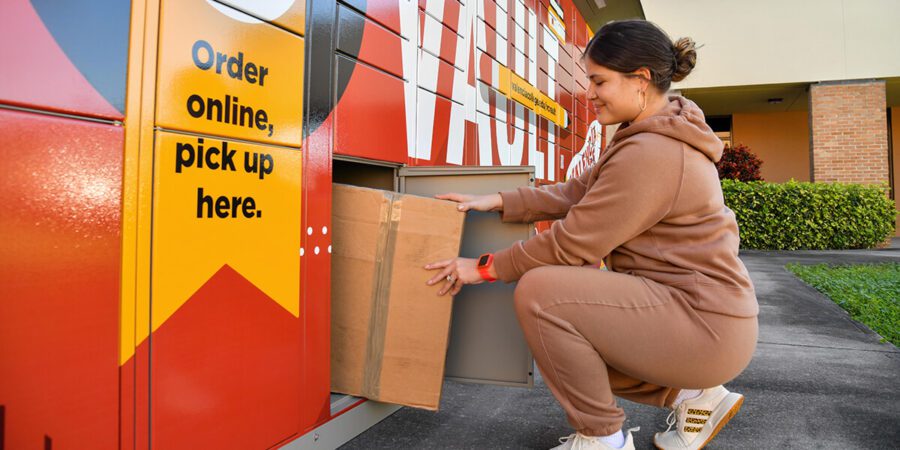
University
Combatting Food Insecurity on Campus: 9 Strategies to Create Nutritional Equity for Your Students
Written by: Parcel Pending
6 Min Read
Published: February 27, 2024
An issue that is typically cast into the shadows is beginning to step into the limelight on college campuses: food insecurity. Its causes and consequences impact more students than previously thought, especially since the pandemic. Below is an issue analysis, plus nine strategies for creating nutritional equity for your students.
Food Insecurity: The Extent of the Problem
Food insecurity is defined as insufficient or uncertain access to food at a household level. On college campuses, the problem has exponentially increased. Whereas the adult population suffers from food insecurity at a rate of 9.8 %, the student rate is between 33-51%.1 A study from the University of New Mexico, for instance, found that 60% or more of its college and university system students suffered from not meeting basic needs.2
The Disparities in Basic Insecurity
Students from underserved communities often face higher instances of basic needs insecurity. Data from a recent Hope Center survey revealed that 75% of Indigenous students, 70% of Black students, and 70% of American Indian or Alaska Native students grapple with issues of food and housing insecurity, as well as homelessness, across two- and four-year colleges.3 A significant proportion (65%) of students identifying as LGBTQ also endured some form of basic needs instability during their student years.
Additionally, the study found that female students are 7% more prone than their male counterparts to face basic needs insecurity.
The Impact of Food Insecurity
The impact of food and financial insecurity is significant. 48% of students reported lower concentration when faced with financial pressure.4 When financially strapped students choose cheaper, highly processed foods, they often overconsume fats, sugars, and refined grains, contributing to sugar spikes and obesity. These students also suffered from:
- Lower Attendance
- Poorer Grades
- Higher Stress
- Lower College Completion Rates
- Lack of Sleep
- Higher Anxiety
Current Contributing Factors to Food Insecurity
Rising costs and inflation are among the factors continuing to affect students’ struggle for food security:
- Higher Tuition Costs – According to US News & World Report, the average tuition price at a private institution rose 4% in 2024 from the 2023 academic year.5 At public schools, the increase was 2%.
- Lack of Understanding Assistance Programs – The Supplemental Nutrition Assistance Program (SNAP) morphed to include college students after the pandemic. However, few students and fewer administrators accurately understand the program and therefore cannot always inform them of its availability.
- Social Stigma – The University of Central Florida found that almost 25% of its students would hesitate to use the campus food pantry due to shame, embarrassment, and pride.6
- Work Salaries and Schedules – Students are likelier to work the lowest-paying jobs as these are often the only ones that accommodate their college schedule.7 Late-night jobs also translate into the students who need meal assistance the most missing the time window for meal plans, pantries, or food assistance.
- Transportation – Geography is critical in determining whether college students can easily access healthy food. A centrally located school or a robust public transportation system helps students access food pantries or cafeterias.
- Cooking Skills – Solid cooking skills allow students to stretch their food dollars. For example, buying bulk grains, beans, or pasta is typically cheaper. Still, if people don’t know how to convert these raw ingredients into tasty meals, they quickly choose more convenient and expensive food options.
How Parcel Pending Lockers Can Lend a Helping Hand
Many higher education institutions are familiar with smart lockers, a solution to help with distributing mail and packages for students, staff, and faculty on campus. However, schools are beginning to expand their functionality beyond the mailroom, including leveraging them as a distribution system for food pantries to combat hunger among campus communities.
Bunker Hill Community College, for example, uses Parcel Pending lockers to help busy students access its food pantry, dubbed the DISH Food Program Pantry. The statistics are impressive: 2,078 pick-ups in 2022, 1,690 collections from a DISH & Dash locker serving almost 500 students. Most importantly, students are able to discreetly enter a PIN or QR code to access a 24/7 locker – without shame or embarrassment. These lockers also aid working students who often cannot access food sources during their off-hours.
Food insecurity is often a silent detractor from staying in school, getting good grades, and retaining health and well-being. Still, there are numerous options available to combat this growing epidemic. For instance, universities can install lockers as part of dining services or near existing vending machines, allowing students to quickly and easily collect food between classes. Whether it’s from a food bank or from other locations around campus, leveraging smart lockers to distribute food works for busy students and those wishing to avoid the embarrassment of retrieving food bank assistance.
Other Strategies to Create Nutritional Equity on Your Campus
When it comes to fighting food insecurity, numerous other strategies can help higher education institutions support their campus community:
- Add Meal Swipe Donation Programs – Meal swipe donation programs, such as those facilitated by Swipe Out Hunger, allow students with surplus meal swipes to contribute to a pool that those in need can access. Moreover, a survey by the Students Against Hunger program at Colorado State University reveals a direct link between receiving meal swipes and improved academic performance.8
- Institute On-Campus Food Pantries – Food pantries provide shelf-stable and sometimes fresh food to those in need, with privacy and discretion as critical considerations for successful implementation.
- Incorporate Food Recovery Programs – In partnership with platforms like the Food Recovery Network, students are notified about available leftover food to reduce waste and ensure students are fed.
- Start Community and Shared Gardens – With sufficient buy-in from students and faculty, community gardens provide or supplement fresh produce from food pantries.
- Demonstrate Meal Prep – For students lacking the requisite knowledge to maintain a healthy diet, cooking, and meal prep demonstrations are a huge boon.
- Connect Students to Resources – Single Stop is a popular anti-poverty organization that regularly partners with community colleges to screen students needing financial assistance, connecting them with resources such as SNAP food stamps, Medicaid, tax credits, child care, and emergency utility services students.
- Build Awareness – Faculty, staff, and administrators must understand and promote the SNAP program.
- Promote Financial Aid – Financial aid is available in various forms. Still, students need assistance locating and applying for it. They also need financial aid packages to lift students from the food insecurity ecosystem. Emergency needs and completion grants can help alleviate the financial burden placed on students, address immediate or long-standing needs, and benefit their academic success.
- Add Financial Literacy Programs – Financial literacy goes hand-in-hand with budgeting. Financial literacy programming, identified as an essential support by a 2018 study, can empower students with the knowledge to budget effectively and consume healthily.9
Discover how you can provide more support, flexibility, and dignity to students experiencing food insecurity with order pick-ups from smart lockers. Speak to one of our parcel management experts today.
Sources:
- Mowreader, Ashley. Report: Addressing the Roots of Food Insecurity in Higher Ed. www.insidehighered.com. December 11, 2023. https://www.insidehighered.com/news/student-success/health-wellness/2023/12/11/five-factors-causing-food-insecurity-among-college
- King, Mary Beth. Survey finds New Mexico college students facing food, housing insecurity. news.unm.edu. May 8, 2023. https://news.unm.edu/news/survey-finds-new-mexico-college-students-facing-food-housing-insecurity
- Olanyian, M., Magnelia, S., Coca, M., et al. Two Pandemics: Racial Disparities in Basic Needs Insecurity Among College Students During the COVID-19 Pandemic. hope.temple.edu. October 3, 2023. https://hope.temple.edu/racial-disparities-basic-needs-insecurity-college-students-covid-19-pandemic
- Mowreader, Ashley. Report: Addressing the Roots of Food Insecurity in Higher Ed. www.insidehighered.com. December 11, 2023. https://www.insidehighered.com/news/student-success/health-wellness/2023/12/11/five-factors-causing-food-insecurity-among-college
- Kerr, Emma & Wood, Sarah. See the Average College Tuition in 2023-2024. www.usnews.com. September 20, 2o23. https://www.usnews.com/education/best-colleges/paying-for-college/articles/paying-for-college-infographic
- Donadel, Alcino. Beating student hunger: 5 ways to overcome food insecurity on your campus. universitybusiness.com. December 11, 2023. https://universitybusiness.com/beating-student-hunger-5-ways-to-overcome-food-insecurity-on-your-campus/
- Thornton, Claire. What makes food insecurity worse? When everything else costs more too, Americans say. www.usatoday.com. December 8, 2023. https://www.usatoday.com/story/news/nation/2023/12/08/us-food-insecurity-getting-worse/71826700007/
- Donadel, Alcino. Beating student hunger: 5 ways to overcome food insecurity on your campus. universitybusiness.com. December 11, 2023. https://universitybusiness.com/beating-student-hunger-5-ways-to-overcome-food-insecurity-on-your-campus/
- Mowreader, Ashley. Report: Addressing the Roots of Food Insecurity in Higher Ed. www.insidehighered.com. December 11, 2023. https://www.insidehighered.com/news/student-success/health-wellness/2023/12/11/five-factors-causing-food-insecurity-among-college



